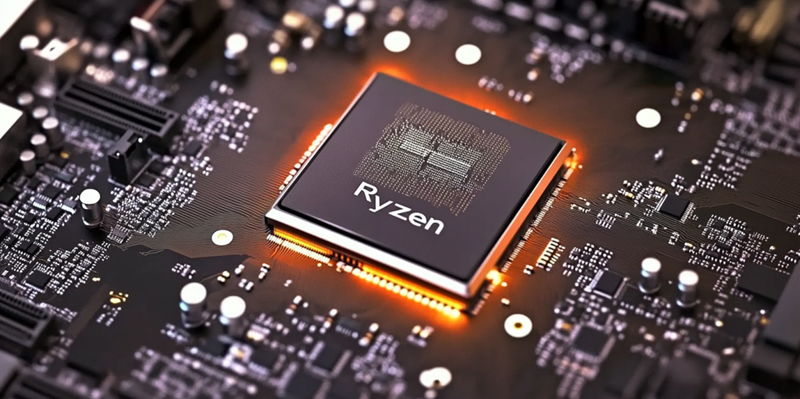AMD is stepping up its game in the handheld gaming market with its latest announcement of the Ryzen Z2 Extreme APU, intended to power the next generation of gaming handhelds. This new APU is set to succeed the Ryzen Z1 Extreme, which is currently used in popular devices such as the ASUS ROG Ally. Unlike its predecessor built on Zen 4 technology, the Z2 Extreme is developed on the more advanced Zen 5 architecture. This transition is part of AMD’s broader strategy to evolve its chip technology, which also includes the Ryzen 9000 and Ryzen AI 300 APUs aimed at desktops and laptops.
Key Specifications and Leaked Information
Central to the buzz around the Z2 Extreme is a recently leaked shipping manifest that reveals key details about the APU. The document discloses the “Z2X28W” designation along with the chip’s ID, “100-000001684.” Crucially, it confirms the APU’s Thermal Design Power (TDP) of 28W. While the expected TDP range for the Z2 Extreme remains between 9W and 30W, the manifest sets 28W as a firm upper limit. This disclosure aligns with AMD’s strategy to balance performance and energy efficiency, a necessity for handheld gaming devices that must juggle power and battery life considerations.
The release timeline for the Z2 Extreme has also been a topic of considerable interest. AMD is reportedly planning an early 2025 launch for the APU. This schedule fits well with the typical product maturity timelines AMD has followed in recent years. The early 2025 launch would position the Z2 Extreme to be a central component in the next wave of gaming handhelds, hitting the market just in time to capture consumer interest during key retail periods such as the summer and holiday shopping seasons.
Advanced Core Configuration and Integrated GPU
The Ryzen Z2 Extreme APU features a unique 3+5 core configuration, meaning it has three full-power Zen 5 cores and five more power-efficient Zen 5c cores. This setup is designed to balance performance and power consumption effectively, crucial for handheld gaming. Additionally, the APU supports hyperthreading and comes equipped with a 16MB cache, which significantly aids in multitasking and improves overall performance. The architecture promises users they can expect smooth gameplay without experiencing the overheating issues that sometimes plague high-performance handheld devices.
One of the standout features of the Z2 Extreme is its integrated GPU, based on AMD’s RDNA 3.5 architecture with 12 Compute Units. The inclusion of the RDNA 3.5 GPU is intended to offer enhanced gaming performance while simultaneously extending battery life—a critical feature for gamers on the go. AMD’s Senior VP, Jack Huynh, has previously highlighted the importance of optimizing both performance and energy efficiency, and the Z2 Extreme appears to deliver on this promise. The integrated GPU is expected to handle modern games at acceptable frame rates, providing a handheld gaming experience that rivals some desktops and laptops.
Industry Comparisons and Market Position
When compared to other tech giants, AMD’s approach seems particularly competitive. MSI, for example, is adopting Intel’s Lunar Lake architecture for its Claw 8 gaming device, while ZOTAC is opting for AMD’s previous generation Zen 4 architecture for its Gaming ZONE handheld. The Ryzen Z2 Extreme aims to offer advantages over these competitors through improved efficiency and power dynamics. The specifications of the Z2 Extreme—especially its unique core configuration, advanced GPU, and balanced TDP—position it as a leading choice for next-gen handheld gaming devices.
A detailed table within industry circles often contrasts these new chip advancements, offering an at-a-glance comparison across metrics such as node process, maximum cores/threads, clock speeds, cache, TDP range, and GPU architecture. This standardized format of presenting information helps to highlight the competitive edge that the Z2 Extreme may have. Such comparisons generally underscore the high-efficiency and robust performance characteristics of AMD’s APU, making it an attractive option for device manufacturers and gamers alike.
Conclusion and Industry Implications
AMD is making significant strides in the handheld gaming market with its latest Ryzen Z2 Extreme APU announcement. This cutting-edge APU is designed to power the next wave of gaming handhelds, taking over from the well-received Ryzen Z1 Extreme found in devices like the ASUS ROG Ally. Unlike the Z1 Extreme, which was based on Zen 4 technology, the Z2 Extreme is built on the more advanced Zen 5 architecture. This upgrade aligns with AMD’s overall strategy to enhance its chip technology suite, which also includes the Ryzen 9000 series and Ryzen AI 300 APUs targeted at desktops and laptops. The Zen 5 architecture promises better performance, power efficiency, and advanced features that can elevate the gaming experience, making it a significant step forward for AMD. As handheld gaming continues to grow in popularity, the Ryzen Z2 Extreme APU positions AMD to be at the forefront of this expanding market, offering gamers more power and efficiency in a portable form. This move underscores AMD’s commitment to pushing the boundaries of technology to meet the evolving needs of gamers.

